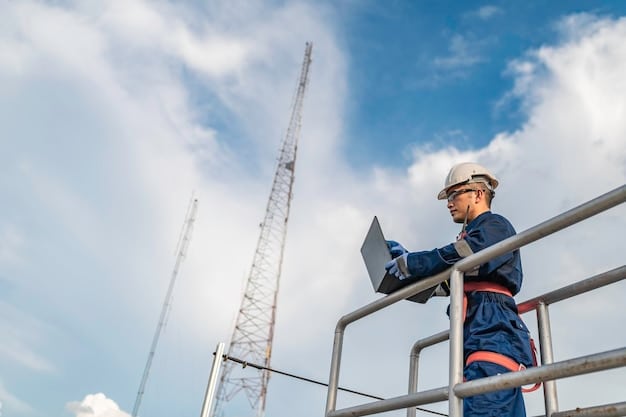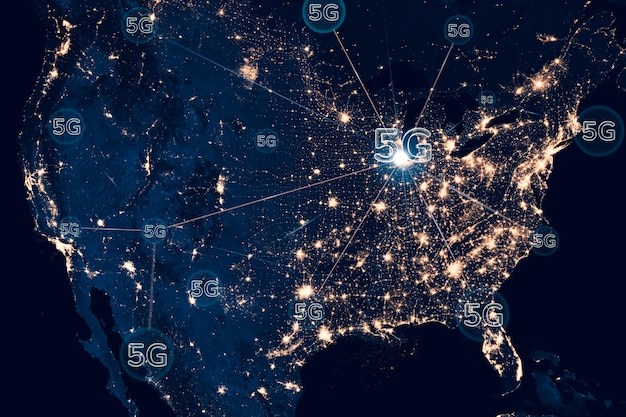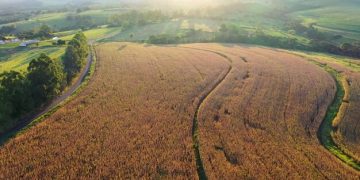5G Expansion in Rural US: Timeline and Connectivity Impact

5G expansion in rural US aims to improve connectivity, yet faces hurdles such as infrastructure costs, regulatory approvals, and technological challenges, with a timeline varying by region and provider, significantly impacting sectors like agriculture, healthcare, and education.
The **5G expansion in rural US** marks a pivotal moment, promising enhanced connectivity and transformative opportunities for communities often left behind in the digital age. Understanding the pace and potential effects of this rollout is crucial for residents, businesses, and policymakers alike.
Understanding the Current State of Rural Connectivity
In the United States, urban areas have largely benefited from high-speed internet and advanced telecommunications, but rural communities often face significant challenges in accessing reliable and fast connectivity. This disparity creates a digital divide, hindering economic development, education, and healthcare access.
Bridging this gap is not just about convenience, it’s about ensuring equitable opportunities for all Americans, regardless of their location. The current state of rural connectivity requires a multi-faceted approach to address infrastructure limitations and affordability barriers.
The Digital Divide: Urban vs. Rural
The digital divide vividly illustrates the stark contrast in internet accessibility between urban and rural areas. While city dwellers often enjoy seamless connectivity, rural residents struggle with slower speeds, limited access, and higher costs.
Key Challenges for Rural Connectivity
Several factors contribute to the challenges of improving rural connectivity, including:
- High Infrastructure Costs: Deploying new networks in sparsely populated areas can be prohibitively expensive.
- Terrain and Geographical Barriers: Rugged landscapes and remote locations can create technical obstacles.
- Regulatory Hurdles: Obtaining permits and navigating regulations can delay project timelines.
Overcoming these challenges requires strategic planning, public-private partnerships, and innovative technologies.

Addressing rural connectivity is an investment in the nation’s future. By closing the digital divide, we can empower communities, foster economic growth, and improve quality of life for millions of Americans.
The 5G Promise: What It Means for Rural Areas
The advent of 5G technology brings forth a revolutionary promise for rural areas, offering unprecedented speed, greater capacity, and reduced latency. These advancements have the potential to transform various aspects of rural life, from business operations to personal communication.
Enabling smart agriculture, telehealth services, and enhanced educational opportunities, 5G is poised to revolutionize the way rural communities function and prosper.
Benefits of 5G Technology
Compared to previous generations of wireless technology, 5G offers several key advantages:
- Increased Speed: Faster download and upload speeds enable seamless streaming and data-intensive applications.
- Lower Latency: Reduced lag times improve real-time communication and enable advanced technologies like remote surgery.
- Greater Capacity: Enhanced network capacity allows more devices to connect simultaneously without compromising performance.
Use Cases for 5G in Rural Communities
The implementation of 5G in rural areas can unlock new possibilities across various sectors:
- Smart Agriculture: Enabling precision farming techniques through IoT devices and real-time data analysis.
- Telehealth: Providing remote medical consultations and monitoring for patients in underserved areas.
- Education: Supporting online learning platforms and interactive educational resources.
These use cases underscore the transformative potential of 5G in addressing critical needs and fostering innovation in rural America.
5G is more than just an upgrade; it is a catalyst for change, capable of transforming the way rural communities live, work, and connect. The investments in 5G infrastructure are investments in the future of rural America.
Timeline for 5G Expansion in Rural US
Understanding the 5G expansion timeline in rural US involves considering various factors, including government initiatives, private sector investments, and technological advancements. While the deployment process is complex, efforts are underway to accelerate the rollout.
The timeline is influenced by collaborative efforts between federal agencies, telecom companies, and local communities, all working towards bringing 5G connectivity to rural America.
Government Initiatives and Funding
Government initiatives play a crucial role in supporting rural 5G expansion:
- The FCC’s Rural Digital Opportunity Fund (RDOF) aims to allocate billions of dollars to expand broadband access in underserved areas.
- The USDA’s ReConnect Program provides grants and loans for rural broadband infrastructure development.
Private Sector Investments
Major telecommunication companies are committing significant resources to rural 5G deployment:
- Verizon, AT&T, and T-Mobile are actively expanding their 5G networks in rural markets.
- These companies are piloting new technologies and partnering with local providers to overcome logistical challenges.
Expected Milestones and Progress
Setting realistic milestones is essential for tracking progress:
- Initial phases focus on upgrading existing infrastructure and deploying 5G in select rural areas.
- Subsequent phases involve expanding coverage to more remote locations and enhancing network capabilities.

The collaborative efforts between public and private sectors are crucial in ensuring that 5G expansion stays on track, transforming connectivity across rural communities.
Expected Impact on Rural Connectivity
The introduction of 5G is expected to have a profound impact on rural connectivity, transforming various aspects of daily life and economic opportunities. From enhanced business operations to improved educational outcomes, the potential benefits are extensive.
With increased speed and bandwidth, 5G connectivity will pave the way for smart agriculture, telemedicine, and remote work capabilities, making rural areas more competitive and resilient.
Economic Benefits
5G connectivity is poised to unlock substantial economic benefits in rural areas:
- New Business Opportunities: High-speed internet access can attract technology companies and startups to rural locations.
- Job Creation: The deployment of 5G infrastructure creates jobs in construction, engineering, and telecommunications.
- Enhanced Productivity: Rural businesses can leverage 5G to improve efficiency and access global markets.
Social and Community Impacts
The social and community impacts of 5G are equally significant:
- Improved Education: Students can access online learning resources and participate in remote educational programs.
- Better Healthcare: Telehealth services can provide remote consultations and monitoring for patients in rural areas.
- Enhanced Public Safety: First responders can use 5G to improve communication and emergency response capabilities.
Addressing Concerns and Challenges
Despite the numerous benefits, certain concerns and challenges must be addressed for a successful adoption of 5G:
Affordability and Accessibility: Ensuring that 5G services are affordable and accessible to all residents. Addressing Infrastructure Limitations: Upgrading existing infrastructure to support 5G technology.
Overcoming these challenges is essential to fully realize the transformative potential of 5G in rural communities.
The positive impact on rural connectivity extends beyond mere technological upgrades; it serves as a catalyst for prosperity, improving the quality of life and fostering economic competitiveness.
Overcoming Challenges in Rural 5G Deployment
Deploying 5G in rural areas is not without its challenges. High infrastructure costs, regulatory hurdles, and technological barriers can impede progress and delay the rollout.
Addressing these challenges requires innovative solutions, strategic partnerships, and effective government policies. Collaboration is essential to ensure that rural communities can fully benefit from the 5G revolution.
Infrastructure Investments
High infrastructure costs can be a significant barrier to rural 5G deployment. Innovative funding models and strategic partnerships are needed to address this challenge.
One approach is to leverage public-private partnerships, where government entities and private companies share the costs and risks of infrastructure development. Another approach is to explore alternative technologies, such as fixed wireless access, to provide 5G services without extensive fiber optic cabling.
Regulatory Considerations
Navigating regulatory processes can be complex and time-consuming. Streamlining regulations and reducing bureaucratic hurdles can accelerate 5G deployment.
Federal and state agencies can collaborate to simplify permitting processes and reduce administrative burdens. The FCC can also play a role by allocating spectrum resources efficiently and promoting regulatory certainty.
Technological Solutions
Technological barriers, such as terrain and geographical challenges, can pose significant obstacles. Innovative technological solutions are needed to overcome these barriers.
One solution is to deploy small cell technology, which uses smaller, low-power base stations to provide coverage in areas where traditional cell towers are not feasible. Another approach is to use satellite-based 5G services, which can provide coverage in remote locations where terrestrial infrastructure is limited.
By addressing these challenges through strategic partnerships, streamlined regulations, and innovative technologies, rural communities can overcome the barriers to 5G deployment and tap into the transformative potential of this technology.
Future Outlook and Policy Recommendations
Looking ahead, the future of 5G expansion in rural US hinges on continued investment, innovation, and strategic policy decisions. Achieving widespread and equitable access to 5G requires a collaborative effort.
By fostering partnerships and prioritizing rural connectivity, we can ensure that the benefits of 5G are accessible to all Americans, regardless of their location.
Continued Investment
Continued investment in rural 5G infrastructure is essential to drive expansion and ensure equitable access. Governments, private companies, and philanthropic organizations all have a role to play in providing funding and resources.
Policy Recommendations
Government policies should prioritize rural connectivity and promote innovation:
- Incentivize private sector investment through tax credits and subsidies.
- Streamline regulatory processes and reduce administrative burdens.
- Promote collaboration between federal, state, and local governments.
The Role of Innovation
Technological innovation will play a crucial role in driving the future of rural 5G expansion. New technologies, such as edge computing and network slicing, can improve the efficiency and performance of 5G networks in rural areas.
The transformative potential of 5G will unfold in rural America, creating the foundation for new economies and enriched communities.
| Key Point | Brief Description |
|---|---|
| 🚀 5G Promise | Offers faster speeds, lower latency, and greater capacity for rural areas. |
| 💰 Economic Impact | Creates new business opportunities, jobs, and enhanced productivity. |
| 🍎 Smart Agriculture | Enables precision farming through IoT and real-time data analysis. |
| 🩺 Telehealth | Provides remote consultations and monitoring for rural patients. |
Frequently Asked Questions
The primary goal is to bridge the digital divide by providing faster, more reliable internet access to rural communities, enhancing opportunities for education, healthcare, and economic development.
5G enables precision farming through IoT devices, collecting real-time data on soil conditions and crop health, optimizing resource use and increasing yields, improving sustainability, and reducing waste.
Major challenges include high infrastructure costs due to low population density, regulatory hurdles, and technical challenges related to terrain and remote locations, requiring innovative solutions and strategic partnerships.
Government initiatives like the FCC’s Rural Digital Opportunity Fund (RDOF) and the USDA’s ReConnect Program provide funding and support to expand broadband access and infrastructure development in underserved rural areas.
5G facilitates telehealth services, enabling remote medical consultations, monitoring chronic conditions, and improving access to specialized care for patients in rural areas, reducing travel times and enhancing healthcare outcomes.
Conclusion
The **5G expansion in rural US** represents more than just a technological upgrade; it’s a pathway to bridging the digital divide and fostering sustainable growth in underserved communities. By overcoming deployment challenges and capitalizing on the transformative potential of 5G, we can unlock new opportunities and enhance the quality of life for millions of Americans.





